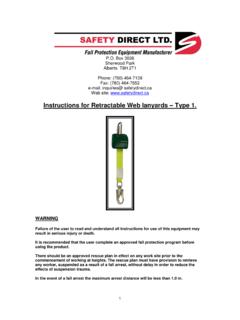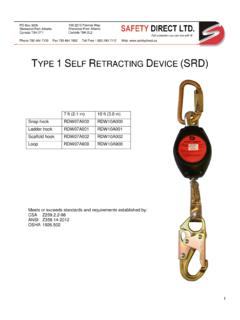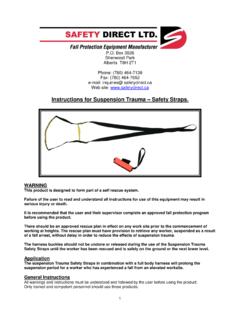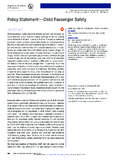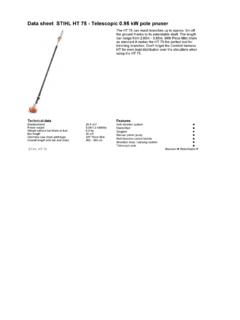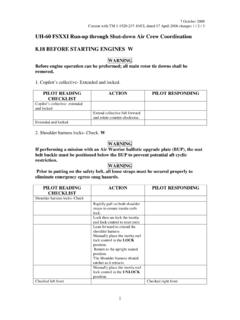Transcription of Instructions for Crossover Style Full Body Harness Model …
1 1 Box 3026 Sherwood Park Alberta T8H 2T1 Phone: (780) 464-7139 Fax: (780) 464-7652 e-mail: inquiries@ Web site: Instructions for Crossover Style full Body Harness Model MH201
2 *US Patent 6874596 2 WARNINGS Failure of the user to read and understand all Instructions for use of this equipment may result in serious injury or death. It is recommended that the user complete an approved fall protection program before using the product. There should be an approved rescue plan in effect on any work site prior to the commencement of working at heights. The rescue plan must have provision to retrieve any worker, suspended as a result of a fall arrest, without delay in order to reduce the effects of suspension trauma.
3 The prolonged suspension of a worker in a Harness as a result of a fall arrest will cause circulatory problems that could lead to loss of consciousness, and result in serious injury or death. In the event of a fall arrest the maximum force, when using a non-energy absorbing lanyard, must not exceed 2 kN. If the force, as a result of a fall, is expected to exceed 2 kN then an energy absorbing lanyard must be used. The Harness is not intended to be used where the worker is to be suspended for prolonged periods of work activity.
4 The use of a Bosun s chair or suspension work seat is recommended. The Dorsal D-ring (as indicated by the arrow and the letter A ) is the only point on the Harness to which a fall arrest lanyard can be attached. The Sternal or Frontal D-ring is for attachment to a ladder climbing system, or to attach to a self-retracting lifeline. The sternal or frontal d-ring should not to be used to suspend the worker at a work site. Pregnant women and persons with a total body weight of less than 32 kg. (70 lb.) should not use this equipment.
5 Proper fitting of the Harness to an individual worker is essential if the Harness is to perform its function correctly. It is important that the shoulder straps and the chest straps are adjusted correctly for a female worker in order to reduce the possibility of injury in the breast area. The chest strap should be adjusted correctly and should be positioned above the breasts. Large snap hooks and carabiners, that have gate openings in excess of 19 mm ( in), should not be used in conjunction with the fall arrest attachment point on the full body Harness .
6 There is a possibility that an accidental rollout or gate failure could result if the gate is subjected to side loading. The Harness includes a fall arrest indicator located on the back shoulder straps below the Dorsal D-ring. If the Harness is subjected to a fall arrest the indicator will be revealed and indicates that the Harness must be removed from service immediately. 3 Fall Indicator Fall Indicator Before Fall After Fall CSA Class or Group full body harnesses are classified according to the following: Class A: Fall arrest (all harnesses must meet the requirements of Class A).
7 Class D: Suspension and controlled descent. Class E: Limited access or confined space. Class L: Ladder climbing. Class P: Work positioning. A full body Harness can have more than one classification and the classification will be recorded on the tag attached to the Harness . General Instructions All warning labels and Instructions must be understood and followed by the user before using the product. All users must understand the relevant regulations and usage standards for fall protection, pertaining to this product, in the jurisdiction in which it is being used.
8 This equipment must only be used by trained and competent personnel. All fall protection equipment must be visually inspected by the worker prior to each use. All fall protection equipment must be inspected by a competent person on a regular basis (at least annually). The results of these inspections should be recorded in a log. Fall protection equipment must not be altered or modified in any way. To reduce the possibility of accidental release, a competent person must ensure that all the systems connecting components are compatible.
9 Any equipment exhibiting deterioration, damage or deformation must be removed from service immediately and inspected by a competent person before being returned to service. Alteration or adaptation of any portion of the Harness will void any warranty or guarantee, either written or implied. Any alteration or adaptation could result in serious injury or death. All equipment subjected to a fall arrest, or where the fall arrest indicators have been exposed, must be removed from service immediately and destroyed. 4 PRECAUTIONS This Harness is intended for use as an integral part of a personal fall arrest system and should not be used for other purposes.
10 Always check before commencing working in an area, that there is sufficient clearance and no obstructions below the work area, so that in the event of a fall the possibility of contact with the surface below the work site is eliminated. The capacity of the Harness is one person 141 kg (310 lb), unless the product label states differently. Only auto locking connecting components should be used in fall arrest applications. In the event of a fall arrest the suspended worker should be rescued without delay in order to minimize the effects of suspension trauma.
